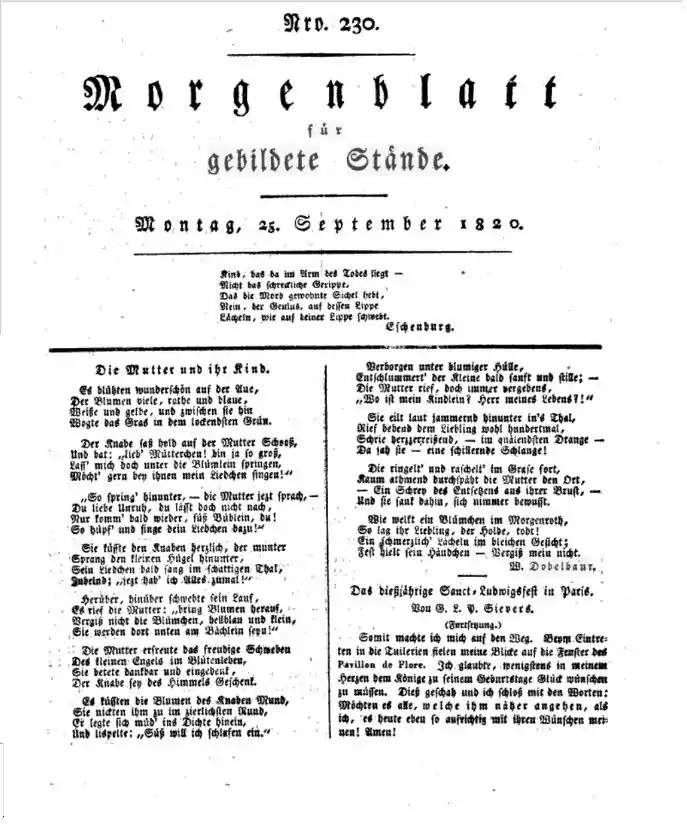| Vergißmeinnicht | |
|---|---|
| by Anton Bruckner | |
 Bartholomäus and Katharina church, Kronstorf | |
| Key | D major |
| Catalogue | WAB 93 |
| Form | Cantata |
| Language | German |
| Composed | 1845: Kronstorf |
| Dedication |
|
| Vocal | SSAATTBB choir – SATB soloists |
| Instrumental | Piano |
Vergißmeinnicht (Forget-me-not), WAB 93, is a cantata composed by Anton Bruckner in 1845.
History
When he stayed in Kronstorf, Bruckner composed in 1845 the first version of this cantata as Musikalischer Versuch nach dem Kammer-Styl (Musical essay in chamber style), which he signed as Candidatus (candidate) for his Lehrbefähigungsprüfung (teacher aggregation).[1][2] Bruckner's examination, which was held in Linz on 27 and 28 May 1845, was successful.[3]
A slightly modified,[4][2] second version was dedicated to Alois Knauer, the parish priest of Kronstorf.[1] The performance occurred on 21 June 1845 (Knauer's name day) or the evening before.[3]
The third version, entitled Vergißmeinnicht (Forget-me-not), was sent to Friedrich Mayer, who was at that time prebendary and choirmaster of the St. Florian Abbey,[1] to remind him of the promise to provide Bruckner with an employment in the Abbey after his successful teacher examination. It is not known when it was performed.[3][5]
The manuscripts of the first and second versions are stored at the Österreichische Nationalbibliothek. The manuscript of the third version is stored in the archive of the St. Florian Abbey. A facsimile of the third version was first issued in band I, pp. 286–300 of the Göllerich/Auer biography.[3]
The three versions of the cantata are put in Band XXII/1 No. 1 of the Gesamtausgabe.[6]
Text

The work is based on the eleven-strophe poem Die Mutter und ihr Kind (The mother and her child) by W. Dobelbaur.
Es blühten wunderschön auf der Aue, |
Wonderfully blossoming on the meadow |
Setting
The cantata in D major is scored for SSAATTBB choir, SATB soloists and piano.[3] The 149-bar long work is in seven movements:[3][2]
- Eingangschor: Es blühten wunderschön auf der Aue - four-part mixed choir
- Recitative: Der Knabe saß hold auf der Mutter Schooß - soprano and alto
- Arie: Sie küsste den Knaben herzlich - soprano and alto
- Duet: Die Mutter erfreute das freudige Schweben - soprano and alto, Allegro
- Quartet: Verborgen unter blumiger Hülle - soprano, alto, tenor and bass
- Duet: Die ringelt' und raschelt' im Grase fort - tenor and bass, Moderato
- Schlußchor: Wie welkt ein Blümchen im Morgenroth - eight-part mixed choir a cappella, Andante
The third version is 7 bars shorter (142 bars), and the first duet: soprano and alto, is replaced by a duet: soprano and tenor.[3]
References
Sources
- August Göllerich, Anton Bruckner. Ein Lebens- und Schaffens-Bild, c. 1922 – posthumous edited by Max Auer by G. Bosse, Regensburg, 1932
- Uwe Harten, Anton Bruckner. Ein Handbuch. Residenz Verlag, Salzburg, 1996. ISBN 3-7017-1030-9
- Anton Bruckner – Sämtliche Werke, Band XXII/1: Kantaten und Chorwerke I (1845–1855), Musikwissenschaftlicher Verlag der Internationalen Bruckner-Gesellschaft, Franz Burkhart, Rudolf H. Führer and Leopold Nowak (Editor), Vienna, 1987 (Available on IMSLP: Neue Gesamtausgabe, XXII/1. Kantaten und Chorwerke Teil 1: Nr. 1-5)
- Cornelis van Zwol, Anton Bruckner 1824–1896 – Leven en werken, uitg. Thoth, Bussum, Netherlands, 2012. ISBN 978-90-6868-590-9
- Crawford Howie, Anton Bruckner - A documentary biography, online revised edition
A rendition of the cantata using a notation software can be heard on Vergissmeinnicht, WAB 93c – entire chorus practice
External links
- Vergissmeinnicht, WAB 93: Scores at the International Music Score Library Project
- Musikalischer Versuch nach dem Kammer-Styl D-Dur, WAB 93 a/b, Vergißmeinnicht D-Dur, WAB 93c - Critical discography by Hans Roelofs (in German)